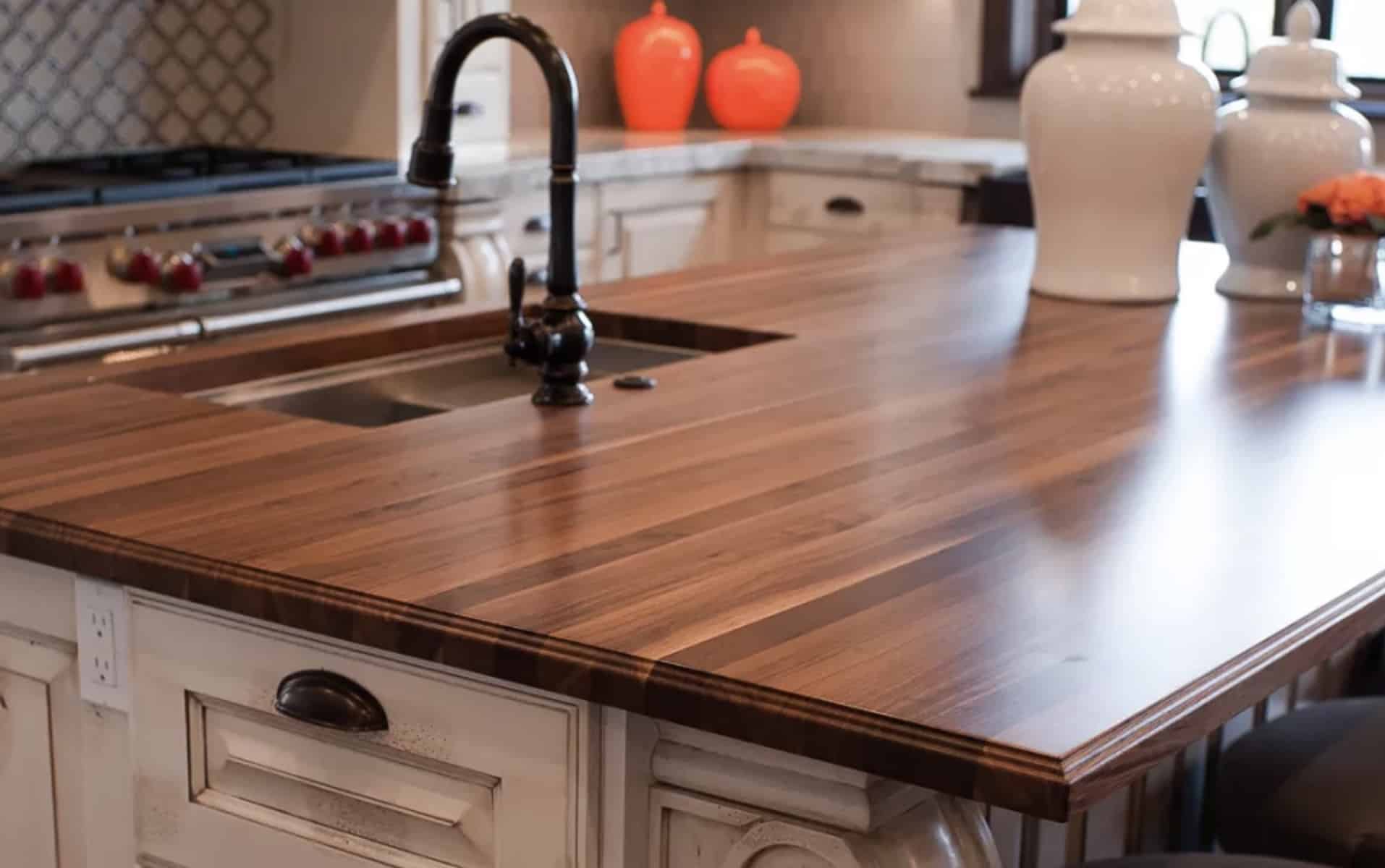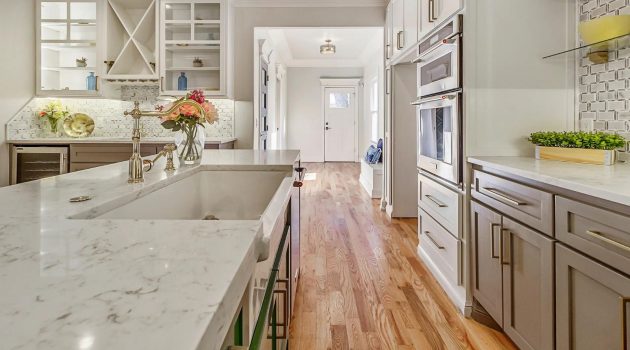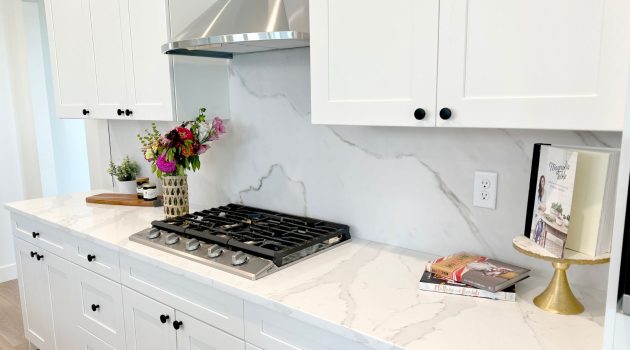If you’re considering a kitchen renovation or choosing the perfect countertop material, butcher block countertops are on your list of possibilities.
These charming and versatile surfaces offer many benefits and a unique look for your kitchen design.
Before making a decision, it’s essential to review the pros and cons to determine if they fit your needs and preferences.
Butcher block countertops are often praised for their warmth and natural beauty, easily fitting into many kitchen styles, from cozy country cottages to rustic farmhouses.
As you weigh the advantages and challenges of installing butcher block countertops in your kitchen, remember that personal taste and lifestyle play a crucial role in your final decision.
Keep an open mind as you research and explore, and you’ll be well on making the best choice for your unique space.
1. What Are Butcher Block Countertops?
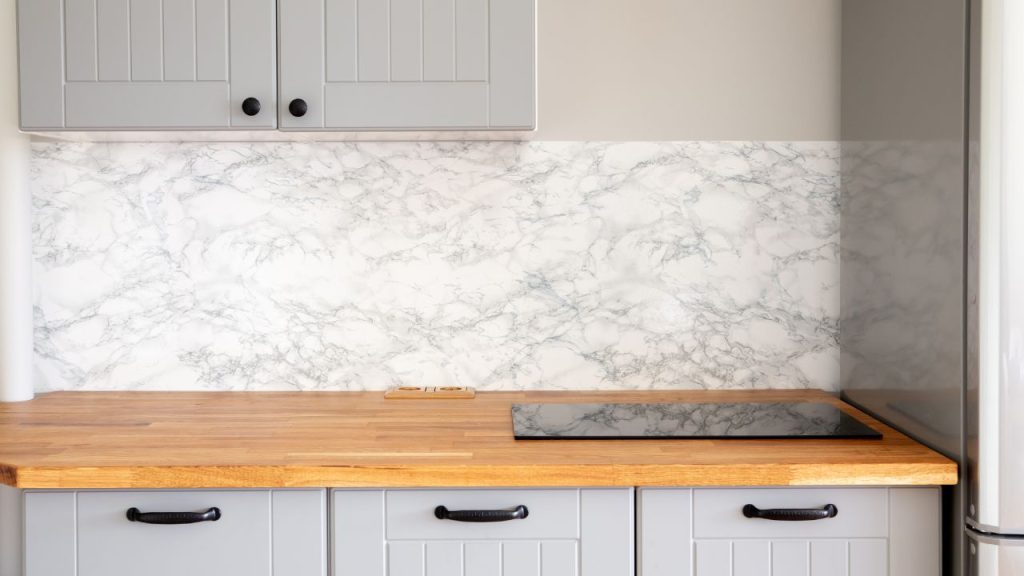
Butcher block countertops have become a popular choice for both homeowners and designers.
They are made from hardwood, such as maple, oak, and walnut, and are constructed by gluing together individual strips of wood.
The result is a durable and visually appealing kitchen countertop.
You might be wondering why people love wood countertops so much. One reason is their warmth and natural beauty, which bring a cozy, earthy feel to your kitchen.
Butcher block countertops are versatile in design and allow you to choose from various patterns, grains, and colors.
This makes them a great addition to almost any kitchen style, whether traditional or modern.
Butcher block countertops also provide a functional advantage, as they are perfect for food preparation and cutting tasks.
Typically, you’ll find these countertops on kitchen islands or near the cooktop, making them a practical and convenient workstation.
However, keep in mind that butcher block material requires regular maintenance to preserve its appearance and longevity.
You’ll need to oil and seal the surface to protect it from water damage, stains, and bacteria, and consider using a cutting board to prevent deep scratches.
2. Different Types of Butcher Block Countertops
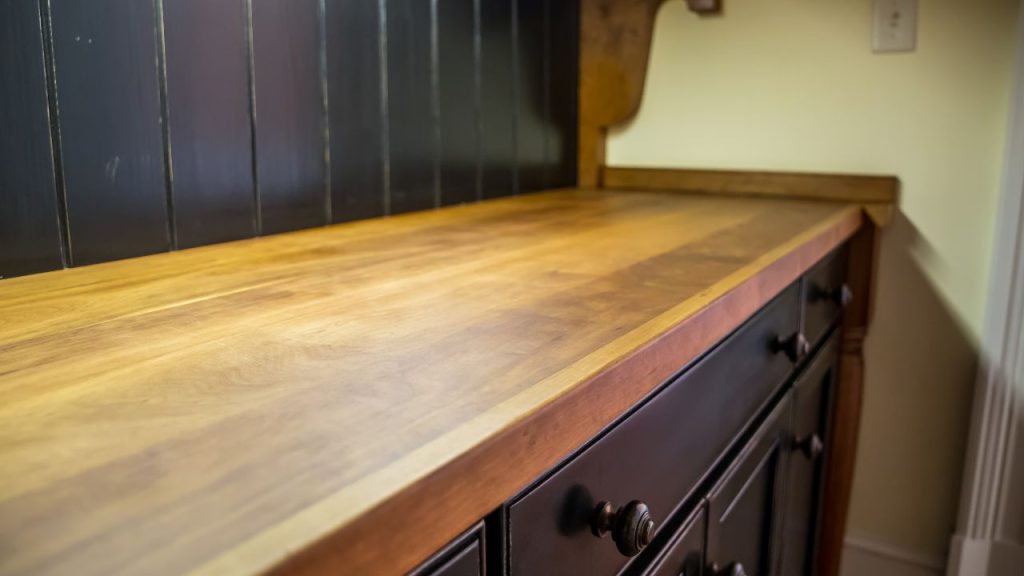
When choosing a butcher block countertop, it’s essential to understand the various types available.
Three primary kinds of butcher block countertops: End Grain, Edge Grain, and Face Grain.
This friendly guide will help you navigate your options and select the perfect countertop for your needs.
End Grain
End grain countertops are created by arranging small wood blocks vertically, with the cut ends facing upward.
This configuration makes the surface extremely durable, as it can withstand heavy chopping and cutting without showing knife marks.
The most common types of wood used for end-grain countertops include:
- Maple: Known for its hardness and durability, maple is perfect for busy kitchens.
- Oak: A strong, resilient wood with a beautiful grain pattern, oak provides excellent resistance to wear and tear.
- Walnut: A prized choice by many homeowners, walnut offers a rich, dark color and unique pattern.
Edge Grain
Edge grain countertops consist of long wood planks glued together on their sides. This creates a visually appealing linear pattern and a relatively stable surface.
Edge grain is less durable than end grain but offers good resistance to regular kitchen use. Here are some popular wood options for edge-grain countertops:
- Cherry: With its rich color and gorgeous grain pattern, cherry is a popular choice for edge-grain countertops.
- Bamboo: Not a true wood but a sustainable and eco-friendly option, bamboo creates a unique, modern aesthetic with its interesting grain pattern.
- Teak: This tropical hardwood is naturally water-resistant, making it an excellent choice for moisture-prone areas like kitchens and bathrooms.
Face Grain
Face grain countertops feature the broad face of wood planks glued together.
This presents the most attractive view of the wood’s natural grain but is also the least durable option, as the surface is more prone to scratches and dents.
Nevertheless, face grain countertops are suitable for light use and can add a luxurious visual element to your kitchen.
Common wood types used for face grain countertops are:
- Maple: As with end grain countertops, maple is durable and lends itself well to the face grain style.
- Cherry: The same beautiful colors and patterns found in edge-grain cherry also look stunning in a face-grain configuration.
- Walnut: A fashionable choice, walnut’s rich tones and patterns shine in face grain countertops.
3. Pros of Butcher Block Countertops
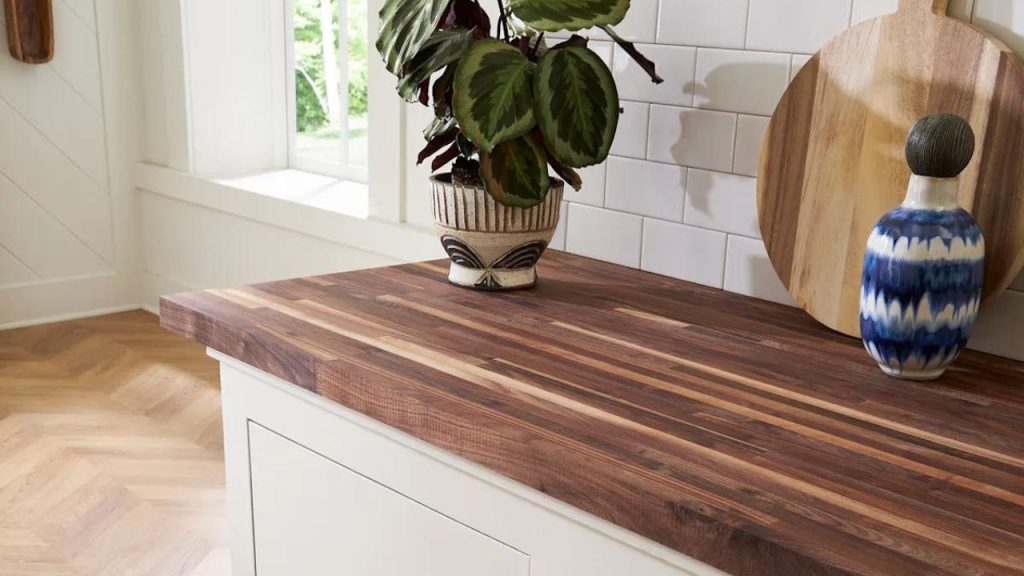
When it comes to choosing the right countertop for your kitchen, butcher block countertops offer a number of advantages over other materials.
Here are some of the main benefits of selecting a butcher block countertop for your kitchen:
Aesthetics
Butcher block countertops have a warm and friendly appearance, immediately making your kitchen feel more inviting.
The natural wood grain adds depth and character to the space, creating a cozy atmosphere you and your guests will surely appreciate.
Versatility
One of the major pros of butcher block countertops is their versatility. With numerous wood species, colors, and grain patterns, you can select a countertop that perfectly complements your kitchen’s design.
Furthermore, you can use butcher blocks throughout your kitchen, including island countertops, end tables, and matching kitchen tables.
Durability
Although not as indestructible as materials like granite or quartz, butcher block countertops are still remarkably durable.
With proper care and maintenance, your wooden countertop can last for years, providing a reliable and resilient work surface.
Environmentally friendly
As a sustainable and renewable resource, wood offers an environmentally friendly alternative to many synthetic and non-renewable materials used in kitchen countertops.
Ease of maintenance
Keeping your butcher block countertop in good condition is a breeze.
Clean the surface with a damp cloth and mild soap, and periodically treat the wood with a food-safe oil or conditioner to keep it looking its best.
A butcher block countertop could be just what you need to add warmth, versatility, and an environmentally friendly touch to your kitchen.
The durability and ease of maintenance make it an attractive option for many homeowners who want a functional and fashionable countertop.
4. Cons of Butcher Block Countertops
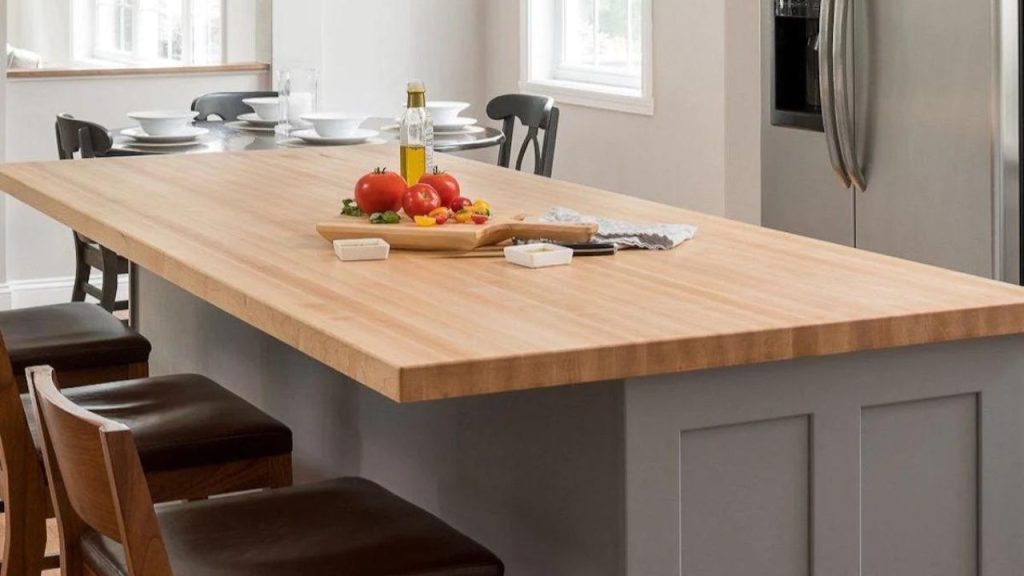
While butcher block countertops can be an attractive option for your kitchen, it’s also essential to consider the drawbacks.
Let’s examine some of the cons that you might encounter.
Maintenance
A significant downside of butcher block countertops is that they require regular maintenance.
You’ll need to oil the surface every few months to prevent it from drying out, cracking, or warping.
Additionally, you should avoid placing hot pots and pans directly on the surface, which could cause burn marks.
Susceptible to scratches
Butcher block countertops are more prone to scratches and other surface damage compared to other materials like granite or quartz.
Be mindful when using knives or other sharp objects, and use cutting boards to protect the surface.
Water damage
Butcher block countertops can be sensitive to water. Prolonged exposure to moisture can cause the wood to warp or crack over time.
Protecting the surface from water damage is important by wiping up spills promptly, avoiding prolonged contact with damp dish towels or sponges, and ensuring proper sealing.
Stains
Wood is porous, which makes butcher block countertops susceptible to staining from spills and substances like red wine, coffee, or acidic foods.
Remember to promptly clean up spills and use trivets or placemats to prevent stains.
Price
While not as expensive as some high-end materials, butcher block countertops can still be pricier, depending on the type of wood and thickness you choose.
Make sure to budget accordingly when updating or renovating your kitchen.
Consider these drawbacks when deciding if butcher block countertops are the right choice for your kitchen. Knowing the cons, you can make an informed decision for your home.
5. Maintenance and Care of Butcher Block Countertops
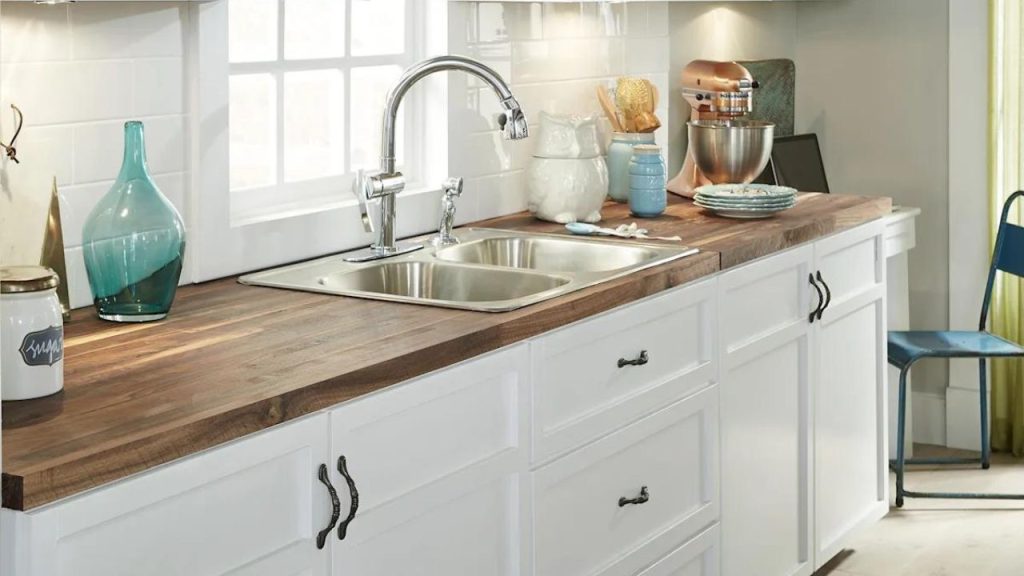
Taking care of your butcher block countertops is essential to maintain durability and appearance.
Here are some friendly tips and guidelines to help you keep your countertops in top shape.
First and foremost, it’s crucial to clean your countertops regularly. You can use a gentle dish soap and warm water for everyday cleaning to wipe away any dirt or residue.
Avoid using harsh chemicals or abrasive cleaning tools, as these can damage the surface of your butcher block.
When you need a deeper clean, mix equal parts water and vinegar to disinfect the surface. If you encounter stubborn stains, scrub the area with a lemon half dipped in coarse salt.
Oiling your butcher block countertops is a crucial step in their maintenance.
Regular oiling with food-safe mineral oil helps to keep the wood hydrated, prevents cracking, and maintains a beautiful finish.
Ideally, you should oil your countertops once a month or when the wood appears dry.
Apply the mineral oil to a lint-free cloth, wipe it along with the grain of the wood, and let it absorb for a few hours before wiping off any excess.
Over time, your countertops may develop minor scratches and dents. You can remedy these imperfections by sanding the surface gently with fine-grit sandpaper.
Follow the wood grain and apply even pressure to avoid creating divots. Once you’ve sanded away the imperfections, remember to re-oil the surface to protect and seal the wood.
Regarding sealants, some homeowners apply a sealant for additional protection, especially in areas prone to water exposure.
If you use a sealant, opt for a high-quality, food-safe product designed for wood surfaces.
Please note that sealed countertops require a different cleaning regimen; consult the sealant manufacturer’s instructions for proper care.
Lastly, be mindful of how you use your countertops. Water and moisture can damage the wood, leading to mold and rot.
Make sure to immediately wipe up any spills and avoid placing wet items on the surface for extended periods.
By following these maintenance and care practices, you can preserve the longevity and appearance of your butcher block countertops for years to come.
6. Butcher Block Countertops Versus Other Materials
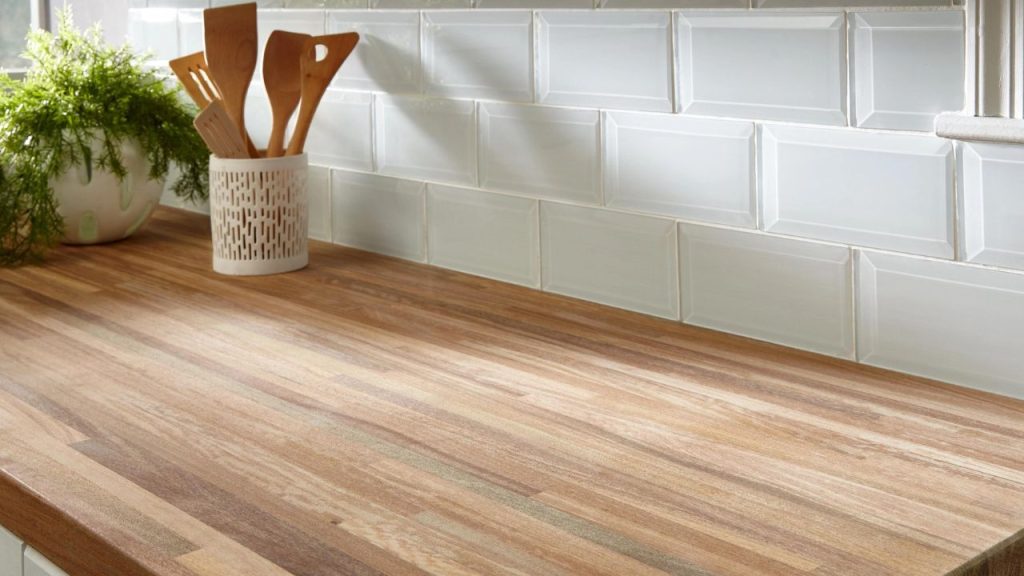
Butcher Block Versus Granite
When comparing butcher block countertops with granite ones, consider that butcher block is warmer and more inviting than the often-cold appearance of granite.
However, granite countertops are much more resistant to heat and scratching.
Butcher block needs more maintenance, such as regular oiling and sealing, while granite is low-maintenance and easy to clean.
Butcher Block Versus Quartz
Quartz countertops offer a wide range of color options and patterns, giving you more design flexibility than the natural patterns of butcher block.
However, quartz can be more expensive and has a different warm, homey vibe than butcher block provides.
Also, quartz is more heat and scratch-resistant than a butcher block, which makes it more suitable for busy kitchens.
Butcher Block Versus Concrete
Concrete countertops have a modern, industrial look that can complement certain design styles.
They are known for their durability and customizability, but they can also be quite heavy and require professional installation.
On the other hand, butcher block countertops are easier to install and give a warm, rustic appearance. However, concrete is more durable than they are and requires regular maintenance.
Butcher Block Versus Marble
Marble countertops are luxurious and elegant but can be more expensive and require regular sealing to prevent stains from penetrating the porous surface.
Butcher block countertops, while less sophisticated, offer a more affordable yet attractive option.
Also, wood is a more forgiving surface when it comes to dropping dishes or glassware, compared to the delicate nature of marble.
Butcher Block Versus Stainless Steel
Stainless steel countertops are popular for professional kitchens due to their durability, heat resistance, and ease of cleaning.
However, they can feel cold and impersonal in a home setting.
Butcher block countertops offer a more welcoming atmosphere but require more maintenance and upkeep compared to stainless steel.
Butcher Block Versus Glass
Glass countertops give a sleek and modern look, but they can be prone to cracks and scratches. Butcher block countertops, though less futuristic, add warmth and charm to your kitchen.
Wood countertops are more forgiving regarding the impact of dropped items, while glass may be more likely to crack or chip under pressure.
Frequently Asked Questions
What is the maintenance required for butcher block countertops?
To maintain your butcher block countertops, regularly clean them by wiping the surface with a mixture of warm water and mild dish soap. Rinse with a damp cloth, then dry them with a clean towel. Apply mineral oil occasionally to preserve and protect the wood, and reseal it every few years. Remember to wipe off any spills to avoid stains and damage promptly.
How durable are butcher block countertops?
Butcher block countertops are known for their durability. When properly maintained, they can last for many years. They’re designed to withstand cutting, chopping, and everyday wear and tear. However, they can be prone to scratches, dents, and water damage if not cared for properly.
What are the costs involved in installing butcher block countertops?
The cost of installing butcher block countertops varies on several factors, such as the type and quality of the wood, the size of the countertops, and labor charges. Generally, prices, including installation, may range from $40 to $150 per square foot. Researching and comparing costs before committing to a specific type of butcher block countertop is essential.
How do butcher block countertops handle heat from pots and pans?
Butcher block countertops are heat-resistant up to a certain point. However, it’s best to use trivets or heat-resistant pads when placing warm pots and pans on the countertops to prevent burn marks and damage to the wood.
Are butcher block countertops a stylish choice for 2023?
Yes, butcher block countertops remain popular in 2023 because of their timeless appeal and versatility. They can complement various kitchen designs, from classic to modern. Plus, they offer a warm, natural aesthetic that adds character and charm to any home.
What are some potential drawbacks of using butcher block countertops?
While there are many benefits to using butcher block countertops, there are some potential drawbacks. These include sensitivity to moisture and heat, susceptibility to scratches and dents, and relatively high maintenance compared to other countertop materials. Ensure you weigh the pros and cons before deciding if they’re the right choice for your kitchen.
